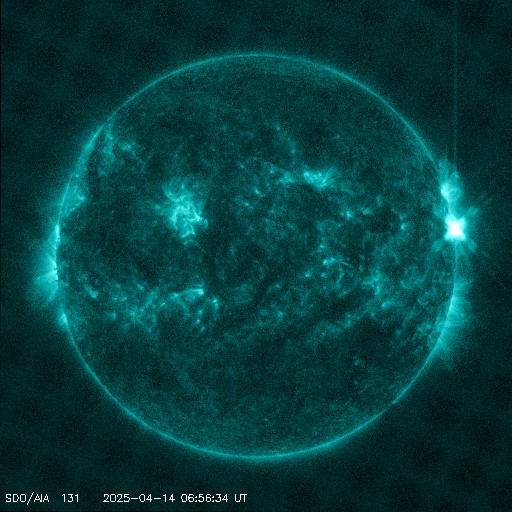Viewing archive of Thursday, 16 June 2005
Solar activity report
Any mentioned solar flare in this report has a scaling factor applied by the Space Weather Prediction Center (SWPC). Because of the SWPC scaling factor, solar flares are reported as 42% smaller than for the science quality data. The scaling factor has been removed from our archived solar flare data to reflect the true physical units.
Report of Solar-Geophysical Activity 2005 Jun 16 2210 UTC# Prepared jointly by the U.S. Dept. of Commerce, NOAA, #Space Environment Center and the U.S. Air Force. #
Joint USAF/NOAA Report of Solar and Geophysical Activity
SDF Number 167 Issued at 2200Z on 16 Jun 2005IA. Analysis of Solar Active Regions and Activity from 15-2100Z to 16-2100Z
Solar activity was moderate. Region 775 (N10W86)
produced an M4.0 flare at 16/2022 UTC with associated Type II (989
km/s) and Type IV radio sweeps. A 170 sfu Tenflare and a CME were
also associated with this event. Region 775 also produced a long
duration C1.7 flare at 16/0905 UTC. Region 779 (S17W05) continues
to show growth, but is developing more slowly.
IB. Solar Activity Forecast
Solar activity is expected to be low.
There is a slight chance for another M-class flare from Region 775
as it rotates around the west limb.
IIA. Geophysical Activity Summary 15-2100Z to 16-2100Z
The geomagnetic field ranged from quiet to major storm levels.
Transient material associated with the CME activity on 14 June
impacted the ACE spacecraft at approximately 16/0830 UTC. A
short-lived period of southward IMF Bz to near -16 nT resulted in a
major storm from 0900 to 1200 UTC. A greater than 10 and greater
than 100 MeV proton enhancement began following today's M4 flare. At
the time of issue, the protons were slowly rising, but had not yet
reached event thresholds. The greater than 2 MeV electrons at
geosynchronous orbit reached high levels today.
IIB. Geophysical Activity Forecast
The geomagnetic field is
expected to be active with isolated minor storming on 17 June due to
the CME activity on 14 June. Conditions should decrease to
predominantly unsettled on 18 June, with quiet to unsettled
conditions expected on 19 June. The greater than 10 and greater than
100 MeV protons are expected to exceed event thresholds early in the
period.
III. Event Probabilities 17 Jun to 19 Jun
| Class M | 10% | 05% | 05% |
| Class X | 01% | 01% | 01% |
| Proton | 90% | 20% | 05% |
| PCAF | Green | ||
IV. Penticton 10.7 cm Flux
Observed 16 Jun 098 Predicted 17 Jun-19 Jun 095/095/090 90 Day Mean 16 Jun 093
V. Geomagnetic A Indices
Observed Afr/Ap 15 Jun 014/021 Estimated Afr/Ap 16 Jun 018/025 Predicted Afr/Ap 17 Jun-19 Jun 018/025-010/015-005/010
VI. Geomagnetic Activity Probabilities 17 Jun to 19 Jun
| A. Middle Latitudes | |||
|---|---|---|---|
| Active | 35% | 25% | 20% |
| Minor storm | 25% | 10% | 10% |
| Major-severe storm | 10% | 05% | 05% |
| B. High Latitudes | |||
|---|---|---|---|
| Active | 40% | 30% | 25% |
| Minor storm | 30% | 15% | 10% |
| Major-severe storm | 15% | 05% | 05% |
All times in UTC
Current data suggests there is a slight possibility for aurora to appear at the following high latitude regions in the near future
Gillam, MB, Yellowknife, NTLatest news
Latest forum messages
2025/04/12-13 Filament CMEs 2025/04/16 G2 Watch 46Ask your obscure/"stupid" space weather questions. 351Incoming & Unnumbered Active Regions 1708Filaments and prominences 61AR 4055 99
More topicsSupport SpaceWeatherLive.com!
A lot of people come to SpaceWeatherLive to follow the Sun's activity or if there is aurora to be seen, but with more traffic comes higher server costs. Consider a donation if you enjoy SpaceWeatherLive so we can keep the website online!

Latest alerts
Monday, 14 April 2025
23:15 UTC - Geomagnetic activity
Active geomagnetic conditions (Kp4) Threshold Reached: 23:01 UTC
07:09 UTC - Solar flare
Moderate M4.28 flare from sunspot region 4055
06:48 UTC - Radio Blackout
Minor R1 radio blackout in progress (≥M1 - current: M1.53)
06:24 UTC - Solar flare
Moderate M1.49 flare from sunspot region 4055
06:06 UTC - Radio Blackout
Minor R1 radio blackout in progress (≥M1 - current: M1.16)
Space weather facts
| Last X-flare | 2025/03/28 | X1.1 |
| Last M-flare | 2025/04/14 | M4.2 |
| Last geomagnetic storm | 2025/04/06 | Kp5 (G1) |
| Spotless days | |
|---|---|
| Last spotless day | 2022/06/08 |
| Monthly mean Sunspot Number | |
|---|---|
| March 2025 | 134.2 -20.4 |
| April 2025 | 128.8 -5.4 |
| Last 30 days | 129.1 -15.1 |





